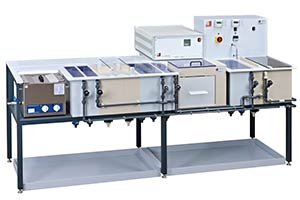Anodising
Systems for anodising light metals are used for surface treatment of parts made of pure titanium or titanium alloys and aluminium.
The plant includes various pre-treatment and post-treatment processes for an optimal anodic oxidation to produce robust surface coatings in decorative colours.
Anodising of titanium, titanium alloys and niobium
The anodising of surfaces, for example titanium, titanium alloys or niobium is an electrochemical process for the surface refinement of components and instruments. This includes a wide range of applications in medical technology for implants, screws, plates, instruments and device components. In addition, this process is used in the decorative sector for watches, earrings, bracelets, chains and ornamental parts as well as in aerospace for the adjustment of thermo-optical properties for housing and structural parts.When exposed to air, titanium or niobium are coated with a natural oxide layer protecting the metal against corrosion. For the use in products, this layer is carefully and completely removed by a special pre-treatment and subsequently rebuilt following a rinsing step. For this purpose, the material is anodised in a special colouring electrolyte using a direct current circuit. The coating is formed from the transformation of the metallic base material into a pore-free oxide phase with a very good resistance and high adherence.
The units are suitable for anodising parts and components made of puree titanium or titanium alloys. All pre-treatment and post-treatment processes for optimal anodic oxidation are included, enabling the production of firmly adhering surface layers in decorative colours.
 |
| COMPACTA Ti |
Anodising of aluminium
Anodising in acidic water-based solutions can strengthen the naturally existing oxide layer. This is conducted on a large scale for aluminium and aluminium alloys. Especially with aluminium, anodising is also called electrolytic oxidising. The thickness of the oxide layer is dependent on the electrical voltage used during anodising. Subsequently, it is still possible to add colour to the aluminium parts. A distinction is made between electrolytic colouring and dip colouring. Different colour shades can be achieved by electrolytic colouring. |
| Anodising plant |




